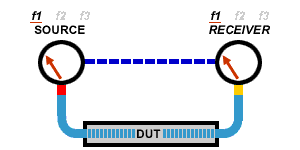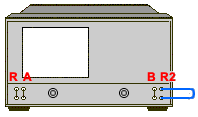
A signal coming out of a device under test may not be exactly the same frequency as the signal going in to a device at a given instant in time. This can sometimes lead to inaccurate measurement results. You can choose between two techniques to eliminate this situation and increase measurement accuracy.
Other topics about Optimizing Measurements
Why Device Delay May Create Inaccurate Results
The following graphic shows an example of this situation:
In the network analyzer, the source and receiver are phase locked together and sweep simultaneously through a span of frequencies.
The signal flow through the Device Under Test (DUT) is shown as different colors for different frequencies.
You can see as a stimulus frequency travels through the DUT, the analyzer tunes to a new frequency just before the signal arrives at the receiver. This causes inaccurate measurement results.
.
If the analyzer is measuring a long cable, the signal frequency at the end of the cable will lag behind the network analyzer source frequency. If the frequency shift is appreciable compared to the network analyzer's IF detection bandwidth (typically a few kHz), then the measured result will be in error by the rolloff of the IF filter.
Note: There is no fixed electrical length of a device where this becomes an issue. This is because there are many variables that lead to measurement speed. When high measurement accuracy is critical, lower the sweep speed until measurement results no longer change.
Solutions to Increase Measurement Accuracy
Choose from the following methods to compensate for the time delay of an electrically long device.
The following methods will slow the sweep speed.
Note: This method applies to VNA models with front panel loops.
Instead of slowing the sweep, you can compensate for the electrical length of a cable or fixture.
Remove the R-channel jumper on the front panel of the analyzer.
Replace the jumper with a cable of about the same length as the device under test.

This method balances the delays in the reference and test paths, so that the network analyzer's ratioed transmission measurement does not have a frequency-shift error.
Note: This method works well if the delay is in a cable or fixture. For devices with long delays, this method is only suitable for uncalibrated measurements.